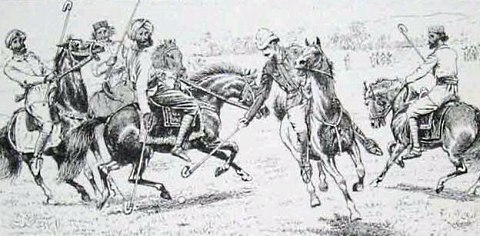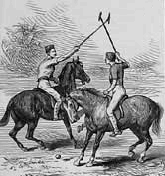马球的起源

马球也许是最古老的团队运动,尽管比赛的确切起源尚不清楚。 它可能是在两千多年前由游牧战士首次进行的,但第一次有记录的比赛是在公元前600年(在突厥人和波斯人之间--突厥人取得了胜利)。 这个名字应该是源于藏语的 "pholo",意思是 "球 "或 "球赛"。 自此以后,它被视为马球运动起源于波斯,经常与社会上的富人和贵族联系在一起;在波斯,国王、王子和皇后都会玩这种游戏。 在最近的英国,马球也与中产阶级和上层社会联系在一起,特别是它在英国起源于民兵。 这也可能是由于它是一种在马背上进行的游戏,需要在每场比赛至少有两匹马,这是一个昂贵的爱好,需要维持。
在中世纪,它被用于东方(从日本到君士坦丁堡)的骑兵训练,几乎被当作一场小型的战斗。 它第一次被西方人所知是通过英国在曼尼普尔(缅甸和印度之间)的茶农,并随着士兵和海军军官传播到马耳他。 1869年,英国的第一场比赛("马背上的曲棍球",因为它起初是指在豪斯洛希思,由驻扎在奥尔德肖特的军官组织的,其中一人在一本杂志上读到了关于这场比赛。

第一套正式的书面规则(目前的国际规则就是基于此)直到19世纪才由英国骑兵队第13轻骑兵队的爱尔兰人约翰-沃森上尉创立。 这些规则在1874年被修订为《赫灵汉姆规则》,限制了每队的球员人数。
然而,马球场的规模(面积近10英亩,略多于9个足球场;是有组织的运动中最大的场地!)自15世纪在古城伊斯法罕(伊朗)的阿里-加普宫前建造的第一个球场以来,一直没有改变。 除了广阔的球场之外、一个被称为 "跑动区 "的区域被使用;在这个区域内发生的比赛事件被视为发生在实际球场范围内的事件!
规则
See_also: 精英罗曼蒂克的女人在空旷的场地上比赛时,每队有4名骑马的球员,但当比赛被限制在一个封闭的体育场时,每队有3名球员参加。 马球没有 "季节",不像其他运动,如足球或板球,因为它可以在室内和室外进行。 一个新的游戏变化是 "雪地马球",完全不受 "坏 "天气模式的限制!只有。然而,由于这些差异,它被认为与传统的马球比赛是分开的。
 一场完整的马球比赛由4、6或8个 "小节 "组成。 每个小节包括7分钟的比赛,之后铃声响起,比赛继续30秒或直到球(现在是白色塑料球或木球,最初由柳树制成)退出比赛。 小节在球结束时结束。 每个小节之间有3分钟的休息时间,半场休息5分钟。在每个小节之间,每个球员将下马并更换小马("马球小马 "这一术语是传统的,但动物通常是马的比例)。 有时,每个小节将骑着一匹新的小马,或两匹小马轮流,但小马通常不会超过两个小节。 每个进球后将更换终点。 比赛和小节在人们看来可能比较短。马球是世界上最快的球类运动,但不是每场比赛的长度。 球员骑在马背上,可以达到很高的速度,并确保球员之间快节奏的传球。 然而,赫灵汉姆规则,即英国的比赛背景,允许一个更沉稳和有条不紊的节奏;多么典型的英国人啊!"!
一场完整的马球比赛由4、6或8个 "小节 "组成。 每个小节包括7分钟的比赛,之后铃声响起,比赛继续30秒或直到球(现在是白色塑料球或木球,最初由柳树制成)退出比赛。 小节在球结束时结束。 每个小节之间有3分钟的休息时间,半场休息5分钟。在每个小节之间,每个球员将下马并更换小马("马球小马 "这一术语是传统的,但动物通常是马的比例)。 有时,每个小节将骑着一匹新的小马,或两匹小马轮流,但小马通常不会超过两个小节。 每个进球后将更换终点。 比赛和小节在人们看来可能比较短。马球是世界上最快的球类运动,但不是每场比赛的长度。 球员骑在马背上,可以达到很高的速度,并确保球员之间快节奏的传球。 然而,赫灵汉姆规则,即英国的比赛背景,允许一个更沉稳和有条不紊的节奏;多么典型的英国人啊!"!
球是用棍子或木槌击打的,就像槌球中使用的棍子的加长版,由每个骑马的球员向两端的球门挥舞。 在几个世纪前曼尼普尔的比赛中,允许球员用马带球,这常常导致球员之间为自己的球队获得球而发生肢体冲突。 该游戏是用右手进行的(有在国际赛场上只有三名球员是左撇子);出于安全原因,1975年禁止左撇子比赛。
在骑兵的机械化之后,也许是对马球运动最热衷的地方,它的受欢迎程度下降了。 但是!在20世纪40年代,马球运动出现了复苏,今天,有超过77个国家在进行马球运动。 在1900年至1939年间,它是公认的奥林匹克运动,现在又被国际奥林匹克委员会承认。

